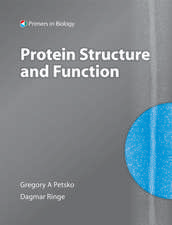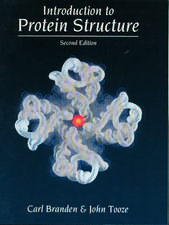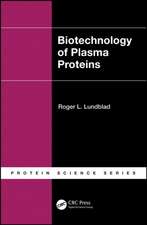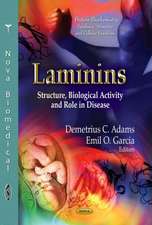Protein Amyloid Aggregation: Methods and Protocols: Methods in Molecular Biology, cartea 1345
Editat de David Eliezeren Limba Engleză Hardback – 11 oct 2015
Authoritative and practical, Protein Amyloid Aggregation: Methods and Protocols serves as an ideal guide for biochemists and biophysicists with an interest in elucidating the mechanisms of protein amyloid formation, as well as chemists, pharmacologists and clinicians with an interest in leveraging an understanding of such mechanisms for the purpose of therapeutic development.
| Toate formatele și edițiile | Preț | Express |
|---|---|---|
| Paperback (1) | 702.41 lei 6-8 săpt. | |
| Springer – 23 aug 2016 | 702.41 lei 6-8 săpt. | |
| Hardback (1) | 589.21 lei 38-44 zile | |
| Springer – 11 oct 2015 | 589.21 lei 38-44 zile |
Din seria Methods in Molecular Biology
- 9%
 Preț: 791.63 lei
Preț: 791.63 lei - 23%
 Preț: 598.58 lei
Preț: 598.58 lei - 20%
 Preț: 882.98 lei
Preț: 882.98 lei -
 Preț: 252.05 lei
Preț: 252.05 lei - 5%
 Preț: 802.70 lei
Preț: 802.70 lei - 5%
 Preț: 729.61 lei
Preț: 729.61 lei - 5%
 Preț: 731.43 lei
Preț: 731.43 lei - 5%
 Preț: 741.30 lei
Preț: 741.30 lei - 5%
 Preț: 747.16 lei
Preț: 747.16 lei - 15%
 Preț: 663.45 lei
Preț: 663.45 lei - 18%
 Preț: 1025.34 lei
Preț: 1025.34 lei - 5%
 Preț: 734.57 lei
Preț: 734.57 lei - 18%
 Preț: 914.20 lei
Preț: 914.20 lei - 15%
 Preț: 664.61 lei
Preț: 664.61 lei - 15%
 Preț: 654.12 lei
Preț: 654.12 lei - 18%
 Preț: 1414.74 lei
Preț: 1414.74 lei - 5%
 Preț: 742.60 lei
Preț: 742.60 lei - 20%
 Preț: 821.65 lei
Preț: 821.65 lei - 18%
 Preț: 972.30 lei
Preț: 972.30 lei - 15%
 Preț: 660.49 lei
Preț: 660.49 lei - 5%
 Preț: 738.41 lei
Preț: 738.41 lei - 18%
 Preț: 984.92 lei
Preț: 984.92 lei - 5%
 Preț: 733.29 lei
Preț: 733.29 lei -
 Preț: 392.60 lei
Preț: 392.60 lei - 5%
 Preț: 746.26 lei
Preț: 746.26 lei - 18%
 Preț: 962.66 lei
Preț: 962.66 lei - 23%
 Preț: 860.22 lei
Preț: 860.22 lei - 15%
 Preț: 652.64 lei
Preț: 652.64 lei - 5%
 Preț: 1055.50 lei
Preț: 1055.50 lei - 23%
 Preț: 883.87 lei
Preț: 883.87 lei - 19%
 Preț: 491.89 lei
Preț: 491.89 lei - 5%
 Preț: 1038.86 lei
Preț: 1038.86 lei - 5%
 Preț: 524.16 lei
Preț: 524.16 lei - 18%
 Preț: 2122.34 lei
Preț: 2122.34 lei - 5%
 Preț: 1299.23 lei
Preț: 1299.23 lei - 5%
 Preț: 1339.12 lei
Preț: 1339.12 lei - 18%
 Preț: 1390.26 lei
Preț: 1390.26 lei - 18%
 Preț: 1395.63 lei
Preț: 1395.63 lei - 18%
 Preț: 1129.65 lei
Preț: 1129.65 lei - 18%
 Preț: 1408.26 lei
Preț: 1408.26 lei - 18%
 Preț: 1124.92 lei
Preț: 1124.92 lei - 18%
 Preț: 966.27 lei
Preț: 966.27 lei - 5%
 Preț: 1299.99 lei
Preț: 1299.99 lei - 5%
 Preț: 1108.51 lei
Preț: 1108.51 lei - 5%
 Preț: 983.76 lei
Preț: 983.76 lei - 5%
 Preț: 728.16 lei
Preț: 728.16 lei - 18%
 Preț: 1118.62 lei
Preț: 1118.62 lei - 18%
 Preț: 955.25 lei
Preț: 955.25 lei - 5%
 Preț: 1035.62 lei
Preț: 1035.62 lei - 18%
 Preț: 1400.35 lei
Preț: 1400.35 lei
Preț: 589.21 lei
Preț vechi: 727.42 lei
-19% Nou
Puncte Express: 884
Preț estimativ în valută:
112.76€ • 117.29$ • 93.09£
112.76€ • 117.29$ • 93.09£
Carte tipărită la comandă
Livrare economică 10-16 aprilie
Preluare comenzi: 021 569.72.76
Specificații
ISBN-13: 9781493929771
ISBN-10: 1493929771
Pagini: 300
Ilustrații: XIV, 314 p. 73 illus., 49 illus. in color.
Dimensiuni: 178 x 254 x 19 mm
Greutate: 0.98 kg
Ediția:1st ed. 2016
Editura: Springer
Colecția Humana
Seria Methods in Molecular Biology
Locul publicării:New York, NY, United States
ISBN-10: 1493929771
Pagini: 300
Ilustrații: XIV, 314 p. 73 illus., 49 illus. in color.
Dimensiuni: 178 x 254 x 19 mm
Greutate: 0.98 kg
Ediția:1st ed. 2016
Editura: Springer
Colecția Humana
Seria Methods in Molecular Biology
Locul publicării:New York, NY, United States
Public țintă
Professional/practitionerCuprins
Semisynthesis and Enzymatic Preparation of Post-Translationally Modified α-Synuclein.- Isotope-Labeled Amyloids Via Synthesis, Expression and Chemical Ligation for Use in FTIR, 2D IR and NMR Studies.- Inter-Molecular Paramagnetic Relaxation Enhancement (PRE) Studies of Transient Complexes in Intrinsically Disordered Proteins.- Detection of Helical Intermediates During Amyloid Formation by Intrinsically Disordered Polypeptides and Proteins.- Fluorescence Correlation Spectroscopy: A Tool to Study Protein Oligomerization and Aggregation In Vitro and In Vivo.- Deep UV Resonance Raman Spectroscopy for Characterizing Amyloid Aggregation.- Analyzing Tau Aggregation with Electron Microscopy.- Characterization of Amyloid Oligomers by Electrospray Ionization-Ion Mobility Spectrometry-Mass Spectrometry (ESI-IMS-MS).- Formation and Characterization of α-Synuclein Oligomers.- Fluorescence Methods for Unraveling Oligomeric Amyloid Intermediates.- Preparation of Amyloid Fibrils for Magic-Angle Spinning Solid-State NMR Spectroscopy.- Spin Labeling and Characterization of Tau Fibrils Using Electron Paramagnetic Resonance (EPR).- Preparation of Crystalline Samples of Amyloid Fibrils and Oligomers.- Quenched Hydrogen Exchange NMR of Amyloid Fibrils.- Studying the Early Stages of Protein Aggregation Using Replica Exchange Molecular Dynamics Simulations.- Computational Methods for Structural and Functional Studies of Alzheimer’s Amyloid Ion Channels.- Analyzing Ensembles of Amyloid Proteins Using Bayesian Statistics.- In Vitro Studies of Membrane Permeability Induced by Amyloidogenic Polypeptides Using Large Unilamellar Vesicles.- Cell Models to Study Cell-to-Cell Transmission of α-Synuclein.- Preparation of Amyloid Fibrils Seeded from Brain and Meninges.
Textul de pe ultima copertă
This detailed volume focuses on methods for the characterization of aggregation processes that lead to the formation of amyloid fibrils and amyloid oligomers which feature in the etiology of a variety of human disorders collectively known as amyloidoses. The scope of the collection includes techniques for visualizing early steps on the amyloid formation pathway, methods for capturing and characterizing oligomeric, potentially toxic, intermediates, strategies for preparing and characterizing mature amyloid fibrils, and approaches for understanding templating and transmission of amyloid aggregates. Written in the highly successful Methods in Molecular Biology series format, the chapters include introductions to their respective topics, lists of the necessary materials and reagents, step-by-step, readily reproducible laboratory protocols, and tips on troubleshooting and avoiding known pitfalls.
Authoritative and practical, Protein Amyloid Aggregation: Methods and Protocols serves as an ideal guide for biochemists and biophysicists with an interest in elucidating the mechanisms of protein amyloid formation, as well as chemists, pharmacologists, and clinicians with an interest in leveraging an understanding of such mechanisms for the purpose of therapeutic development.
Authoritative and practical, Protein Amyloid Aggregation: Methods and Protocols serves as an ideal guide for biochemists and biophysicists with an interest in elucidating the mechanisms of protein amyloid formation, as well as chemists, pharmacologists, and clinicians with an interest in leveraging an understanding of such mechanisms for the purpose of therapeutic development.
Caracteristici
Includes cutting-edge methods and protocols for studying protein amyloid aggregation Provides step-by-step detail essential for reproducible results Contains key notes and implementation advice from the experts Includes supplementary material: sn.pub/extras













